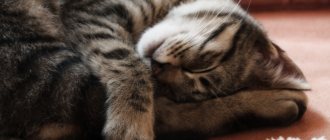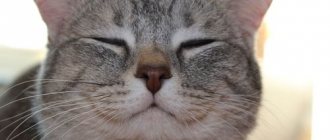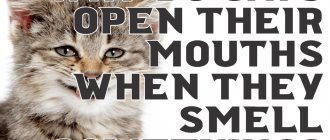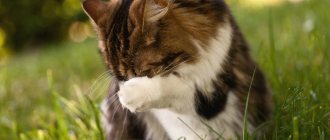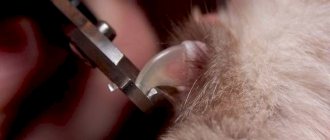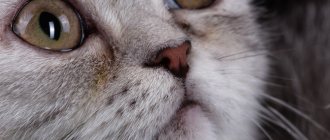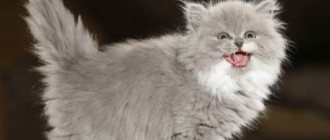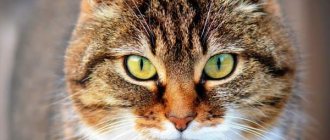9467Administration
4
Any cat lover who has these beautiful creatures living in his home has no doubt noticed how they actively trample with their front paws, diligently massaging their bedding, blanket, or the owner himself. Why a cat tramples with its front paws is of interest to many. There is not a single version that answers this question. They all talk about the natural instincts inherent in the pet from birth.
Having learned more about them, the owner will better understand his furry pet and explain to himself why the cat tramples with its paws. This will allow you to establish the closest relationship with the cat, which will make living in the same house especially interesting.
© shutterstock
A number of false explanations for the seemingly unusual behavior of a pet that tramples with its front paws, and if the owner is guided by them, then he will not be able to understand his pet. In such situations, there is a chance that the relationship with the animal will become strange, and the cat will receive chronic stress from feeling vulnerable and helpless.
It is also unacceptable to punish an animal for its natural behavior, even if the cat is trampling and accidentally stuck its claw at the owner. This is tantamount to scolding a person because, being cold, he begins to shift from foot to foot and shudder. There is an answer to how to change the pet’s behavior if it begins to displease you without causing psychological trauma to the cat. Several recommendations are given in this article; all that remains is to choose one method that is suitable for a particular situation.
What is a “milk step” and where does it come from?
Fingering with the front paws, accompanied by purring, is most often associated with childhood memories. It is called the "milk step". Kittens use this kind of massage to knead their mother’s mammary glands. It stimulates milk production and allows the baby to eat heavily.
The feeling of satiety and security “under the wing” of a mother cat brings very pleasant emotions, so many animals retain this habit even into adulthood.
Reasons from the point of view of scientists
Of course, no one can accurately answer the question of why a cat tramples you with its paws. People have only some assumptions why she does this:
- Childhood memories. According to natural data, in order for a kitten to receive mother's milk, it is forced to put pressure on the mammary glands. This is how stimulation and release of nutrition for the baby occurs. Childhood memories settle in the kitten’s mind, and already in adulthood, in moments of calm, out of inertia, he performs similar actions. After all, he experiences the same warm feelings for his owner, and the cat is rewarded with such signs of attention only by his loved ones, and not by everyone living in the same house with him.
- The next assumption why cats trample is a natural instinct. In ancient times, when cats were wild animals, they made their own den. To do this, they trampled down the vegetation, thereby making it soft, and at this time they walked in a circle. Now they do not need such movements, but the instinct is passed on from generation to generation.
- Another version is a sense of ownership. Zoologists claim that cats have special glands in their paw pads that secrete sweat, with such a subtle odor that only cats can smell it. In a similar way, the pet marks the owner from other cats, thereby saying that he is busy.
- Another idea why cats trample is to check the territory. That is, with such movements they check whether everything is in order for comfort. It is with their paws that pets check for cold and sharp objects.
- Another version of why cats trample, which people really adore, is that a person and his pet understand each other so well that they feel the emotional mood, whether there is any disorder or even depression. If cats trample us with their paws, then in this way they want to improve the internal state of the owner. During these actions, the pet releases a hormone of joy: endorphin, which has a calming effect on the owner and pet.
- Another assumption is that the cat at this time feels a hormonal surge and the need for a cat. Neutered cats also suffer from this; their needs for the opposite sex do not go away immediately, but after some time.
Why do cats knead their paws?
All existing reasons explaining why cats knead their paws are divided into instinctive and conscious. The first include:
- preparing a bed;
- sexual desire;
- marking the territory;
- hunting.
Unlike instinctive ones, conscious reasons are explained by a real desire for the act of trampling. These include:
- demonstrating love and trust;
- host treatment;
- stress relief.
Below you can get acquainted with all of the above in more detail.
Memories of a protected childhood
Touching a person with their paws after a hearty meal or stroking them is a sign of gratitude, love and trust. After separation from the mother, her role is taken over by the owner, since it is he who is responsible for the satiety and protection of his pet.
At the moment of trampling, some animals manage to suck a human finger or other parts of the body, smacking their lips with pleasure with their eyes closed.
Sometimes similar actions are performed in relation to soft things: blankets or large plush toys. Such “betrayal” should not be taken seriously, because your knees are not available 24/7, and no one has canceled the “milk step” according to the schedule and spontaneous desire.
Preparing the bed
The second reason explains why cats knead their paws before going to bed. It is associated with instinct, preserved from wild cats.
Animals who want to take a nap necessarily crush the grass under them. By marking time in one place, they not only create the most comfortable shape for the future “bed,” but also drive out the insects that have accumulated there with their vibrations.
Despite some common features, getting ready for bed and the “milk step” are still different. In the first case, purring is very rare, and kneading is often accompanied by scratching.
Sexual desire
The onset of heat is easiest to track in females. They arch their backs, raise their butts and fussily move their hind legs. This unusual behavior is accompanied by loud meowing and occasional rolling on the floor.
Under the influence of hormones, males show interest in soft blankets and toys. Having chosen an object of adoration, they begin to knead it with their front paws and purr with pleasure, periodically shifting their hind legs.
In contrast to the “milk step,” arousal is accompanied by small tremors throughout the body, and after completion of the immediate imitation of sexual intercourse, the animal begins to actively lick the genitals.
Mechanism
How does a cat’s “purr” work, and what is it anyway? Have you ever wondered how kittens create this sound and why people like it so much? There are several theories about the origin of purring.
Vocal cords
Taking a closer look at your animal, you will probably think that the tummy makes a continuous sound. But that's not true. There is an opinion that a cat purrs precisely through the vocal cords, but the process “starts” in the cerebral cortex. The muscles of the larynx, at the behest of the animal, begin to vibrate sweetly and emit a soothing and pleasing purr (or, conversely, the battle cry of meowing).
Diaphragm
Scientists also believe that purring sounds come from the diaphragm or, more simply, from the lungs. That is, they are provoked by vibrations in the cat’s lungs. Experts think this because the cat purrs in time with its breathing. This set the stage for thought.
Vascular theory
The vascular theory states that the “clattering” occurs due to the pressure created in the cat's body by the blood circulation. Under the influence of certain emotions, the pressure difference causes the chest to vibrate and the cat makes the very sounds that we hear and call “purring.”
These are mysterious animals! And yet, scientists have solved the mystery! The vibration spreading throughout the body comes from the hyoid bones. They are located between the base of the skull and the base of the tongue of animals.
Reference! It is because of the contraction of the muscles of the vocal cords that vibration occurs, accompanied by pleasant purring sounds.
Unconfirmed assumptions
The remaining reasons are considered unconfirmed assumptions. They also explain why cats knead their paws, but they have some nuances that do not allow them to be classified as the main ones.
Marking territory
The sweat glands of mustachioed pets are located directly on the pads of their paws, so in the heat they leave wet marks on the tiles. In addition to cooling the body, the enzymes released help repel uninvited guests. This feature is actively used for marking territories. Most often, females resort to it, since males spray an odorous secretion when urinating.
When marking territory, cats practically do not trample, but simply scratch with their paws. Unlike regular kneading, such touches increase the coverage area and increase the security of the territory.
Hunting
If we consider all possible reasons, then it makes sense to note the hunting instinct. He explains why cats crush the surface with their hind paws before attacking. In this case, this movement helps to ensure safety: the absence of noisy leaves and too soft soil under the paws in which you can get stuck.
Despite the fact that in most domestic animals the role of prey is played by a toy mouse, and the role of soil is a stable laminate, the habit inherited from wild ancestors is still preserved.
Host treatment
Cats love warmth, so they can sense inflammation a mile away and prefer to “heal” their owners. In fact, they simply settle down on the warmest and softest place possible, massaging it before curling up into a ball.
Vibrations during purring really have a beneficial effect on health, but the removal of negative energy and the miraculous treatment of diseases with their help is just a myth. If after a cat massage your mood and well-being improve, then it is important to understand that “after” does not mean “as a result.” Most often, these problems are solved by banal rest and taking medications.
Stress relief
The last unconfirmed hypothesis explaining why cats paw is associated with endorphin, the pleasure hormone. Cat pads are equipped with many receptors responsible for the sense of touch. Trampling soft and pleasant to the touch surfaces stimulates the production of endorphins, reducing stress levels.
Because of this, many pets wrinkle the blanket after returning from the veterinarian or a recent punishment for stealing sausages. At such moments it is better not to touch them, since before the steam is completely released they can take out their dissatisfaction on your hand.
Popular opinion
Traditional healers, when asked why a cat tramples on its owner, give a different interpretation. It is likely that the mustachioed magician finds a place that has less vital energy. By performing a massage with their front paws, they seem to be treating us, bringing energy balance. When a cat seems to enter into a role, trampling on a person’s body, it seems to be in a misunderstanding of what is happening at this moment. It is at this time that the exchange of bioenergy occurs between the animal and its owner.
Eastern sages, studying this phenomenon, claim that cat energy is closest to human energy. This phenomenon does not occur in any other animal. During bioenergetic contact, healing occurs. Eastern medicine claims that 15 minutes of cat massage can relieve depression, and it’s not at all scary when a kitten digs its claws into the skin, thereby stimulating the active zones of the body. They act like needles during acupuncture.
Experts believe that there is no difference whether a purebred pet or a barn cat does the massage. The main thing is that the pet warms up to the owner, so that he likes the person. Cats have an amazing ability to lie down and massage the area where there is a problem.
What should an owner who is in pain from the “milk step” do?
If a cat tramples you with its paws and at the same time actively releases its claws and scratches your skin, do not rush to drive it away or scold it. Such an attitude can destroy the established trust. Instead of punishment, it is recommended to try more harmless options.
Laying soft cloth
The easiest way is to carefully place a soft blanket or thick clothes under your pet that you don’t mind. Thanks to this cape, the massage will bring extremely pleasant sensations.
If the long and sharp claws continue to scratch even after placing fabric, try distracting the cat with a toy or gently turning it over on its side. Once in a lying position, she will calm down and go to sleep. It is also recommended to simply stroke the paws on top. This action will cause the claws to retract instinctively.
Cat manicure
Timely cat manicure not only prevents scratching and damage to furniture, but also prevents delamination of the claw covers. During the procedure, only the light part is cut off with a nail clipper, and the shortened claw must be trimmed with a file.
If you are afraid of harming your pet, seek help from a groomer or purchase silicone anti-scratch caps. They are fixed to the claws with special glue, which is included with the main kit.
What you should never do
In most cases, trampling on the owner is a way of showing love, so it should be encouraged, not suppressed. Prohibited actions during the “milk step” include:
- screams;
- repulsion;
- spanking and other types of physical punishment;
- surgical declawing, or onychectomy.
A sharp reaction can lead to severe stress and other unpleasant consequences.
Pets have the hardest time undergoing onychectomy, as this operation deprives them of a number of vital functions. Due to numerous mental disorders, painful recovery and the development of dangerous complications such as osteomyelitis, in most European countries declawing is equated to animal cruelty.
Therapeutic effects on humans
According to professional breeders, pets are capable of healing. This theory is partly true. It has been scientifically proven that they can help a person.
Treatment with cats or feline therapy is a therapeutic technique that anyone can resort to if they are not allergic to wool. Cats are able to sense the owner’s mood; if treated gently, he will come to the rescue when you need to relieve tension.
In addition to the fact that cats help you feel better, their purring calms the human nervous system.
However, rumbling has another function - thickening the bones. Pets use it to heal fractures, since the frequency of sound vibrations from 20 to 50 Hz has a positive effect on bone tissue.
Doctors recommend communication with cats for people diagnosed with schizophrenia, cerebral palsy, and autism. Regular communication will help in socialization of children, becoming a good friend. The care shown by pets normalizes the human condition.
What not to do
There are a few simple rules for how to behave when a cat crushes objects:
- The main thing is not to scold your pet, so as not to lose his trust.
- Under no circumstances punish the cat for such actions, because this is his natural instinct.
- You cannot use physical force to prevent your pet from trampling down the blanket.
- Don’t limit your attention after the cat’s behavior like this, continue to encourage and pet him.
By following these simple rules, you will maintain a trusting and friendly relationship with your little family member.
Selecting a territory
It is believed that the sweat glands on the paw pads of cats are involved in the process of identifying territory. The chemical composition of secretions in all living organisms, including humans, is unique to each individual. Animals can indeed communicate in this way what belongs to them. This is an instinctive process and it occurs spontaneously: a signal is recorded in the pet’s brain about the need to mark the territory. The favorite is reminded of this by the most ancient mental attitudes.
If a cat tramples a person with its paws, this means that the animal appreciates him and wants the owner to always be with him.
Tags
About the cat behind the cat Why does the cat trample when cats are happy does the cat purr does the cat purr in the cat's body circulation and the cat makes noises that the cat is lying down Cats are very fingering their paws and fingering their paws and Why or Why a cat Why an animal and why he Why or Why a cat treatment of cats Feeding cats fear of cats of cats modern cats checked cats can Among cats white
dogarticlecommentarysocietyfeedquestionsworldverykitten tramplinganswerversionswithoutsitemomentbackrecordingnewsvoice
Marriage span
Cats are always overly active when their mating season begins - they immediately physiologically feel that it is time to have offspring. At this time, your little friend is most active. The cat becomes very active, can move its paws a lot, arch its back and perform additional actions. That's why cats knead a person's paws and purr - perhaps your pet wants to tell you something. Do not react aggressively to the cat's behavior during this period - she may bite and become very angry. After pregnancy begins, the cat’s activity will begin to decline.
Results
Cats are very sweet pets, whose presence in the house can bring real joy to their owner. You need to understand that sharpening its claws is a natural behavior of any cat, so you should not scold it for such actions. If you don’t like this cat’s “activity,” simply switch the cat’s attention to another object or toy. Treat your pet kindly, and he will definitely reciprocate you with love.
More from my site
- A cat yells at night - what to do How to stop a cat from yelling at night, since these sounds will certainly not allow you to live in peace. The well-being of its owner depends on the balance of the tail. This behavior can happen […]
- Devon Rex cats Devon Rex is a cat that bestows “canine” devotion and a whole bouquet of pleasant emotions. At first glance, the Devon Rex is surprising: its strange appearance and increased friendliness; big ears and [...]
- The cat began to mark - what to do At what age do cats begin to mark their territory, what to do and how to fix it. The situation becomes tense for all residents after being tagged due to the unpleasant odor. You shouldn’t immediately [...]
- Oncilla - an unusual breed of cat The oncilla cat is a unique animal of the cat family, living in the vastness of Central and South America, Argentina, Brazil, Colombia and Costa Rica. Cats of this breed today [...]
- How often can you wash a cat? How to wash a cat when most people don’t like to take baths. The question remains relevant even when the furry is a homebody and does not often walk outside. If you teach a cat to swim with [...]
- Choosing food for your pet Many dog and cat people are accustomed to buying food for their pets in supermarkets or regular grocery stores located near their home. There you can find the most [...]
- Demodectic mange is a subcutaneous mite in cats. Demodectic mange can cause severe discomfort and pain in cats. The treatment regimen depends on the stage of the disease, the age barrier and the weak immunity of the animal. Therefore, a caring owner should [...]
- Cat diseases Cat diseases, symptoms are what owners of furry creatures often encounter. The presented table and treatment, which you will find in the article, will help you identify cat diseases […]
- The Balinese cat is a graceful breed of cat. The Balinese cat was born at the beginning of the 20th century. The breed is a semi-long-haired cat with a non-standard color. Balinese or Balinese is very accessible in content, without […]
Showing love and affection
But it’s not just the desire for control that animals express in this way. Cats often place their paws on top of their hands when they are overwhelmed with feelings of tenderness, affection and love.
Animals whose owners are away from home for a long time especially often express their affection in this way and caress people. Cats left alone for a long period of time begin to feel bored and melancholy. And by placing their paws on top of a person’s hands or on a person’s face, the animals try to keep the owner close to them and receive as much attention and affection from him as possible.
Massage for kittens
When a kitten is taken away from its mother, its diet changes, which often leads to bowel problems. Cats lick the tummy and genital area of their babies to encourage them to defecate. Therefore, if a kitten is constipated, you need to massage its tummy with your finger or a sponge soaked in water. This simple procedure imitates the licking of a cat and in most cases causes pushing.
And if the kittens are bottle-fed, then massaging the peritoneum and anal area after each feeding is a mandatory procedure.
